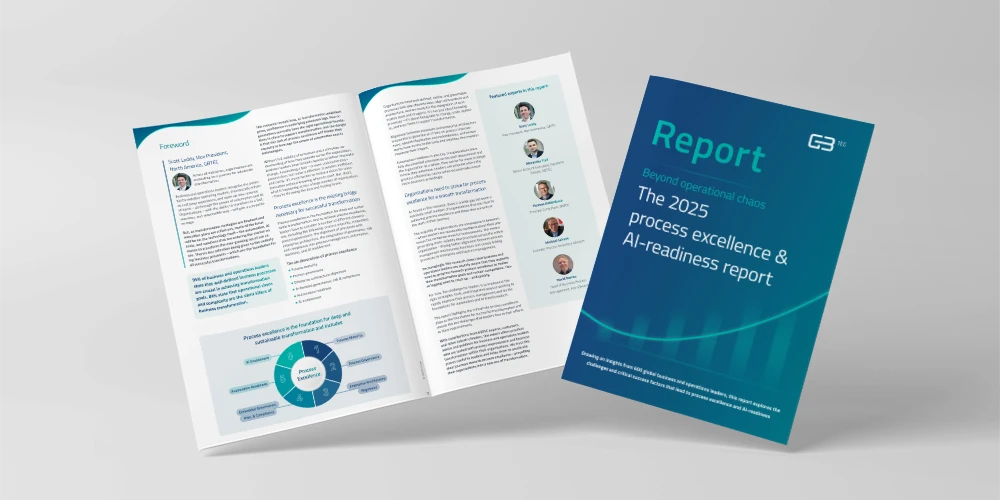From AI to Digital Twins: The Top 5 BPM Trends Shaping 2026
Digital transformation has become and will be one of the core topics for many organizations. In fact, according to Grand View Research, the global digital transformation market size was estimated to reach USD 4,617.78 billion by 2030, growing at a CAGR of 28.5%. In 2026, the most successful organizations will be the ones who are able to effectively utilize technology and advancements in agentic AI as a companion to achieve process excellence by ensuring that company-wide processes are accurately mapped out and automated like a well-oiled machine.
In this blog post, we outline the top 5 BPM trends for 2026, and how you can stay ahead of the curve by kickstarting your digital transformation initiatives for the new year. These trends are:
- Agentic AI becomes a process co-worker
- Model-to-Execution pipelines close the last mile
- Digital Twins of the Organization (DTO) go operational
- The rise of transformation task forces
- Single-source platforms beat fragmented tools

Have you checked out our process excellence report yet?
Before we continue with the trends, here's a resource you might find useful. Our latest report Beyond Operational Chaos: Achieving Process Excellence for AI-Ready Business, shares valuable insights on how top organizations build the foundation for successful AI and automation in Transformation. Drawing from 600 global business leaders, it explores how operational chaos derails success, and why clear, governable processes are key to achieving process excellence,
Download the full report and start driving growth with AI today!
1. Agentic AI becomes a process co-worker
2026 will be the year of process-led AI and HumanTech collaboration. While agentic AI will play a key role in streamlining and standardizing processes, its effects can only be fully realized if the foundation and groundwork have been properly laid by process teams. Without a solid foundation, deploying AI will only lead to the automation of chaos and greater compliance risks. Be it SOPs, policies, or workflows, process teams need to take control by creating a standardized, governed, and explainable blueprint, which acts as guardrails so that AI agents can work the way you want them to. This HumanTech collaboration is the secret recipe to helping you achieve process-led AI, enabling you to achieve faster cycle times and cut rework.
How to start:
- Pick one value stream and ensure it has clean inputs (e.g., only one form for data input, well-defined fields, clear definition of “done”)
- Use AI to draft a process model based on your SOPs and assign named owners to approve the process
- Pilot an agent on a narrow sub-process, define success metrics (e.g., cycle time, error rate, SLA attainment) and an audit trail
2. Model-to-Execution pipelines close the last mile
For many companies, the biggest gap is turning “the model on the wall”, into the “the thing that actually runs”. In other words, process execution. In 2026, this gap finally closes with executable models (BPMN for flows and DMN for decisions) being directly deployed and real-time telemetry feeding improvements back to process owners. Models will become more than just documentation, evolving into digital-first deliverables with granular tasks, inputs, outputs, policies, SLAS, and control points encoded. The roles and responsibilities of each step will be clearly defined (human vs agent), so all stakeholders have oversight and are aligned on escalation protocol. This shortens release cycles, reduces translation errors, and creates built-in governance, allowing businesses to execute their processes in a quicker fashion.
How to start:
- Pick a process and map it out for a workflow engine to execute (BPMN – defining the steps and handoffs, DMN – defining the decision rules)
- Deploy the model into your BPM platform and turn on tracking so you can monitor metrics like SLA attainment, error, and rework
- Set up a monthly process health review with the owner and team to analyze the data and iterate
3. Digital twins of the organization (DTO) go operational
In 2026, DTOs no longer live in powerpoint slides. With real-time data being fed continuously, DTOs will become always-on control towers that will help teams make better decisions on flow, cost, and risk, helping you spot bottlenecks early. As business process complexity continues to increase, DTOs act as a sandbox for you to test changes and quantify impact before you go live with it. When operationalized, DTOs map your processes, systems, controls, data, and KPIs, then let you run what-if simulations, allowing you to deploy the best scenario.
How to start:
- Build a minimal twin for one of your workflows (Don’t model everything. Keep it to the main steps, systems, handoffs, and wait times so it reflects reality well enough to test ideas)
- Feed it with a couple of real KPIs and cost/risk parameters
- Run two simulations, make one change, and measure the difference between the twins
4. The rise of transformation task forces
Companies have realized the value of involving risk teams early in the process design stages as opposed to consulting them later as an afterthought. Doing so reduces rework, costs, and audit pain and ensures that all teams are aligned from the get-go. 2026 builds on this trend by blending BPM, risk, compliance, security, data protection, and enterprise architecture teams into one transformation unit. Instead of only getting input after go-live, cross-functional transformation squads co-design processes, decisions, controls, and supervise AI together. According to KPMG, many organizations have already begun accelerating risk transformation, integrating their risk systems, processes, and domains by undertaking more cross‐functional collaboration and forming task forces.
How to start:
- Identify a value stream to pilot your transformation task force
- Set up the transformation task force by including members from process management, risk, compliance, security, and enterprise architecture
- Involve all members of the task force and get their input on process design and future reviews
5. Single-source platforms beat fragmented tools
Tool sprawl is the silent killer of visibility. As business processes and workflows become more complex, teams may start looking for different tools to make their job easier. However, as the number of tools increases, data and insights become decentralized, preventing teams from having a single source of truth. 2026 rewards teams that defragment into a single operating platform, linking processes, decisions, documents, SOPs, controls, enterprise architecture, automation, and monitoring. In this way, teams only need to go to one place to govern change across all parameters, allowing AI, DTOs, and model-to-execution pipelines to scale because the data is consistent. This greatly increases the efficiency of cross-functional collaboration, enabling decisions to be made from data from one source.
How to start:
- Inventory your current tech stack and consolidate models that are duplicated or out of sync
- Choose a platform that supports model-to-execution, decision modeling, and enterprise architecture management
- Migrate one value stream end-to-end before expanding to other value streams
Bringing it all together
These 5 trends are not necessarily independent. In fact, they reinforce each other.
- Agentic AI only performs reliably because the process is modeled to execution due to the controls put in place by humans
- DTOs surface where to improve next and allows you to visualize the KPIs before you go live
- Transformation squads combine the best of all worlds, and ensure process, risk, security, and architecture are aligned from day one
- A single-source platform keeps models, decisions, and data in one place and facilitates quicker decision making
Ready to realize your digital transformation projects in 2026?
Find out how GBTEC’s AI-powered BIC Platform enables you to drive digital transformation, allowing you to bring process design, execution, enterprise architecture, and compliance all under one roof.






















